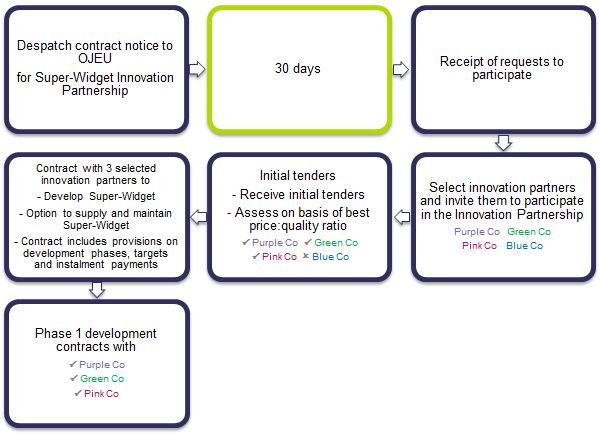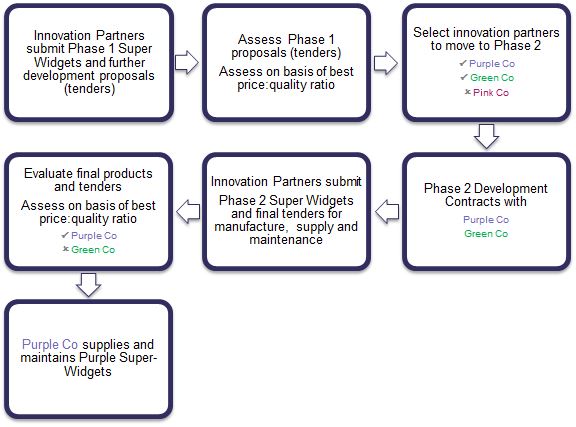22/05/2014

Research and innovation is at the centre of the "Europe 2020" strategy for smart, sustainable and inclusive EU-wider growth.
Contracting authorities are encouraged to make strategic use of procurement to spur innovation. The Innovation partnership provisions are one of a number of new measures in the new Public Sector Directive supporting this aim.
What are innovation partnerships? Innovation partnerships are a new concept in EU procurement law. They are intended to be long term partnerships which allow for both the development and subsequent purchase of new and innovative products, services or works.
The term "partnerships" is not used in a technical sense to mean legal partnerships as defined under UK law. The term is used to indicate the partnering type approach to working together.
Why is a new procedure required? Under the old directives contracting authorities wishing to support innovative research and development faced a practical problem: they may well have been able to justify awarding an R&D contract without competition. If the outcome of the R&D process was a useful product contracting authorities were often unable then to purchase the product direct from the developer without a further competition.
The Innovation partnership procedure is aimed at resolving this problem by wrapping up in one procurement process 1) the appointment of one or more innovation partners; 2) parallel innovative development work as well as permitting the number of partners to be reduced; and 3) an option for the contracting authority to purchase the innovative supply, service or works developed as a result of the Innovation partnership.
What does the new Directive/Regulations say?
The Regulations define "innovation" as "the implementation of new or significantly improved" products, services or processes - (Article 2/Regulation 2). The non-exhaustive definition covers:
- production
- building and construction
- a new marketing method
- a new organisational method in business practices
- workplace organisation or external relations
This broad definition will cover a wide range of procurements, from development of a single specialist product to, potentially, major outsourcing arrangements.
The new or significantly improved products, services or processes should be implemented with the purpose of helping to "solve societal challenges" or support the Europe 2020 strategy. From a practical perspective, contracting authorities will need to have a clear audit trail demonstrating how the proposed arrangements achieve this objective and fall within the definition of "innovation".
How to run an innovation partnership
Article 31/Regulation 31 sets out how to run an Innovation partnership procedure. There are a range of options available to contracting authorities. We will not cover all of the detail in this Byte. What we aim to do is to give you an idea of just one way in which an Innovation partnership might operate, with some pointers to key issues.
The Super-widget Innovation Partnership Project
- The contracting authority needs a widget of a type which is currently not available on the market. It would like to see if there are organisations which are able to research the contracting authority's requirements and develop prototypes.
- If the prototypes look promising the contracting authority would like the option to develop one or more of the prototypes further.
- If, as a result of this R&D there is a widget which can be manufactured to meet its requirements then the contracting authority would like the further option to purchase those widgets, together with a maintenance contract.
- The contracting authority decides to use an Innovation Partnership procedure
Part 1: Advertisement, selection of innovation partners and initial development phase

Keynotes
Advertising and time limit
- The contracting authority must advertise in the OJEU
- There is a 30 day statutory minimum time limit from despatch of the contract notice to the OJEU and the closing date for receipt of requests to participate
Procurement documents
- Procurement documents must be available by electronic means from the date of publication of the OJEU contract notice. Access to the procurement documents must be unrestricted, full and direct and free of charge (Article 53/Regulation 53(1)).
- The procurement documents must define minimum requirements together with other information relating to the innovation partnership and the conduct of the process. The information must be sufficiently precise to enable economic operators to understand the nature and scope of the required solutions. This is so that they can decide whether or not to submit a request to participate
Selection
- Selection criteria shall include capacity in R&D and developing and implementing innovative solutions
- The contracting authority must invite a minimum of 3 economic operators to participate in the innovation partnership procedure, provided that there are 3 suitably qualified economic operators
Assessment of Phase 1 tenders, moving on to phase 2, final tenders and award of a supply and maintenance contract
Keynotes
Phasing
- An Innovation Partnership can be structured in successive phases, following the sequence of steps in an R&D process.
- There are specific provisions relating to notification of changes in specifications and procurement documents
- The innovation partnership shall set intermediate targets to be attained by the partners and provide for payment in instalments. Failure to meet targets can provide the basis for contract termination.
- The duration and value of the different phases must reflect the degree of innovation and sequence of R&D activities required.
Negotiation
- The provisions envisage the possibility of a series of tenders during the innovation partnership, reflecting the phasing of the project. All tenders, except final tenders, can be negotiated with the partners. Negotiation is not permitted on minimum requirements and award criteria
- During negotiations contracting authorities must ensure equal treatment of all partners and maintain confidentiality
Award
- Initial, subsequent and final tenders are envisaged
- Final tenders cannot be negotiated
- Award criteria must be disclosed in the OJEU contract notice, invitation to confirm interest or procurement documents.




